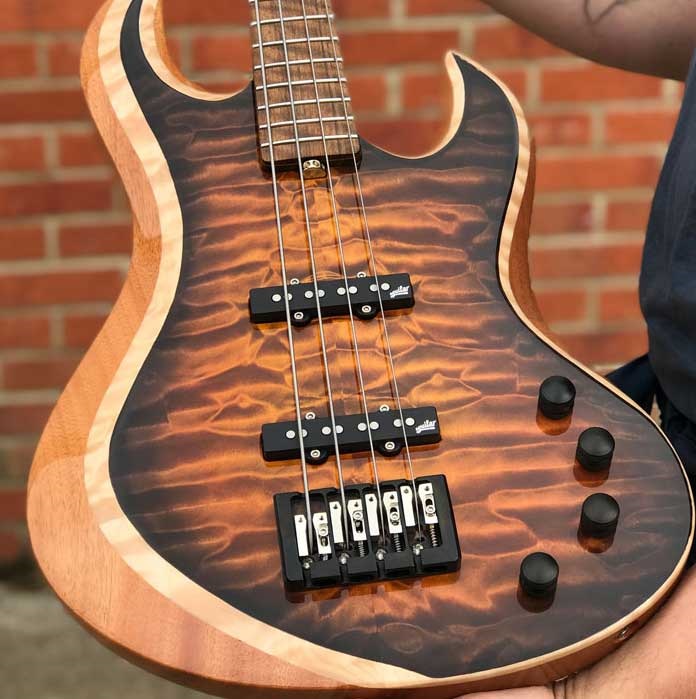Pretty darned good, as you’ll hear from the video below.
A quick 101 on flatwound strings
Tight
Flats, unless specifically stated otherwise, have tighter tension at pitch compared to roundwound. An example of a flat that isn’t tight is the La Bella Low Tension string. However, some would argue a flat that isn’t tight doesn’t really bring about that great sound flats have. If you’ve never tried flats before, it is suggested you use the traditional style that are tight when tuned to pitch. Easy options are La Bella Deep Talkin’ and Rotosound 77.
You don’t need a ’72 Fender P for that great flatwound sound
Getting the right flatwound sound doesn’t require a vintage Fender bass guitar. However, it does help if you have a bass guitar specifically dedicated to using flats and nothing else. Switching back and forth from roundwound to flats can sometimes be more trouble than it’s worth.
Flats, like any other string, do require break-in time. If trying flats for the first time, get a dedicated bass guitar for it, even if it’s a cheap Squier. Alternatively, you can use your existing bass guitar, but keep in mind you will have to perform string height and truss rod adjustments as the string tension will be different compared to roundwound.
Flats cost more
Roundwound is the cheapest bass string. Flats are some of the most expensive because they cost more to make. Fortunately, flats last a long time, but yes, you will spend more on a set.
A glorious ’72 Fender with flats
Great tone, great bass.




Round wound is still the best
Anyone have thoughts on “bright” flats or “ground” strings?
“Modern” bass tone that is so prevalent is a far cry from original bass tone. Sure, it has it’s place, but bass should sound warm and FAT. Played rounds for years (been gigging for 40+ years). Tried flats, but never gave them enough chance. Now playing a gig that requires flats (band boss wanted old school tone). Once I got used to the different (better IMHO) tone, I’ll never go back to rounds. No string screech, easy to EQ, easy on the fingers and yeah, they last forever. Converted all my basses but 1 to flats and never looked back.
Those were some fresh flats. I have a couple of basses dedicated to flats and my experience is they sound like that when fresh, but 3 hours later, no so much. The best I’ve ever used are Thomastik-Infeld silk wrapped jazz bass strings – incredible! And so’s the price $75 for a 4er set.
I used Dr. Thomastik strings back in the day. At the time new bass players were playing Rotosounds and I switched. Immediately I had callous issues, or blisters I should say and I was playing every day. I liked the brightness of roundwounds far better and still do even though they were tougher to get used to. Labellas were more reasonable than the Thomastiks but didn’t hold the tone as long. I would never go back to flats. To my ear they get lost in a mix and if I want a retro sound, today’s electronics and plugs let me dial it in. It’s a shame you never A-B’ed the flats against rounds on a ’72 Precision. The rounds make it a new bass.
Callous issues are principally due to wrong technique. Always practice to touch the string on the corner of the fret. It requires much less pressure on the string and the frequency is more accurate and the tone better,…and bye bye callous.
Same thing for guitar.
To practice, start at 5th fret. Place and hold the 5th fret with the index finger on the big string (B or E) then do a chromatic scale being careful to touch on the corner of each fret with the tip of the finger while not moving the index. Switch string, do the same. Go up one fret and repeat process. Eventually you will be able to start on 1st fret. That will give you a good finger stretch as well.
I’ve gone with the Thomastik and will never go back. The tone just cuts at a reasonable volume. I am part of a host band for a jam session. Last night a fellow came in with a custom made, boutique instrument with round wounds. Sorry…lots of highs and lows but no “meat”.
Since I am primarily a string bassist the flats feel natural to me. I have spent a lot of time and money trying the differnent flats and for me the Chromes work best. I never had trouble getting highs out of the flat strings, it’s a matter of how you attack the strings.
I use nothing but La Bella Deep Talkin’ Bass strings on my basses including my ’71 P-bass. I get plenty of high frequency and the lows are very warm. I feel they are a great string for most styles of music.
Thomastik on my fretless, round on my J-Bass. Complete range of sounds between the two.
does anyone have issues with flats breaking on string through bridges?
String-through bridges aren’t great for the low strings. They kill the tone of round wounds and break flat wounds. I recommend tapered core strings if you can find them with a long enough taper. Ken Smiths are a good bet. LaBella makes a special flat wound for string through bridges, but make sure you are getting the special set. I got a set with a sticker on it that said “for through body bridge” but the E broke before it was anywhere close to pitch. I complained and they sent a new set the next day. It felt like it had a taper core under the flat wire over the bridge area. They tuned up fine and sound great on my ’68 Tele bass, very close to a Tomastik tone but with higher tension.
I have played flats and they do have that old school sound. But the tension is a bit to high for me. I did however figure out how to get that sound with roundwounds, RotoSounds btw. I play a Precision bass and have the two covers that originally came with p basses. I did some research about the bridge cover foam rubber mute that is attached to the underside and decided to get some to make it just like the original ones (the stock ones you can buy now don’t have the foam). Got it all setup and wow…Motown/Wrecking Crew heaven! It’s the real deal soundwise…even has that McCartney sound (Ricks have mutes too). So, it isn’t always about the flatwound strings getting that tone to die for.
My opinion is not humble. After 58 playing bass October this year I caaaaaan tell you flat wound strings are just the best!
Oh 😉 Such a good day to see my extremely quick made video here ;)))
I tried a set of flatwound Dadderio on my P bass. I really loved what they could do, but so much of my technique is tied to round wound strings. There are things I do that just don’t translate on flats. If it were practical to take more basses to the gig, I might keep a bass strung with flats. My P bass through 2 15s and plenty of power, is a brain melting combination of dark fat and full tone. A good example of it is McCartney’s bass part on “Come Together”.
McCartney probably used flats on “Come Together”. In fact he probably took it a step further and used nylon tape wound Rotosounds on his Ric for that tune.
McCartney probably used flats on “Come Together”. In fact he probably took it a step further and used nylon tape wounds on his Ric for that tune.
Good sounding bass; I have a Lakland 5-string P to which was added a bridge J pickup and an Aguilar OBP-1 with a passive tone/preamp bypass switch, strung with DR Legends. Strings are high tension but still very playable, imo. Active eq gives me lots of tonal options.
There is no definitive sound. All sorts of different players use different sounds and different strings help give us a choice. Flatwounds are great for a warmer, softer sound but ifyou want a “modern” sound or use a slap technique, then a bright set of rounds would be better. I use plastic flatwounds on a fretless with an oak fingerboard and I like the sound i get; it suits my playing style.
I love La Bella DT strings. However, I have never liked that vintage P bass sound. I rea;ize that Im in the minority though,